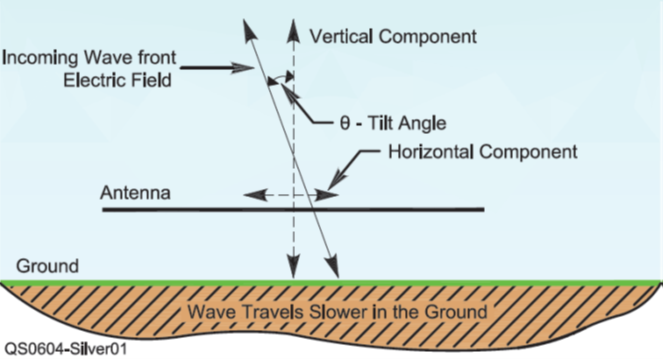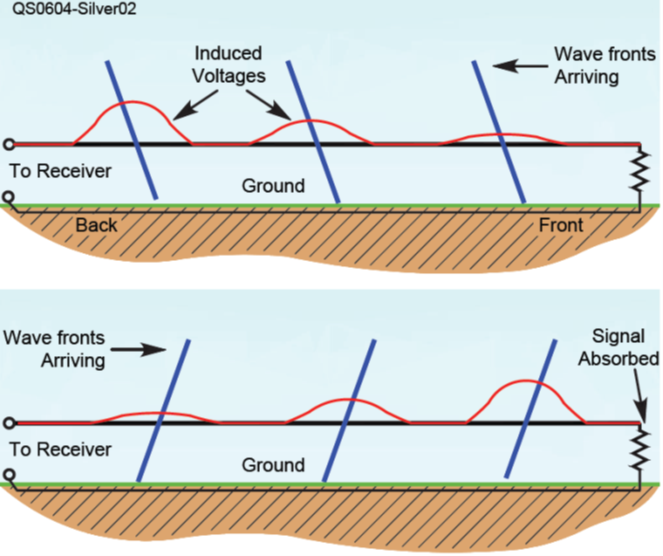(Thanks to the ARRL for sharing Figures 1-3 from the article “The Beverage Antenna, 100 Years Later” in the November 2021 issue of QST—see the reference list below.)
There is a certain mystique about Beverages—the receiving antenna kind, anyway. When the conversation turns to how a certain station manages to work DX on 80 and 160 meters, night after night, voices are lowered and heads nod up and down as it is observed, “Well, they have Beverages!” What are these magic antennas? Do they really take acres and acres of real estate? What’s the secret sauce? Read on—they are simpler than you think.
Why Use a Beverage
Beverage antennas, invented by Harold Beverage, then W2BML, are used on 40 meters (7 MHz) and lower frequencies all the way down into the long-wave region well below the AM broadcast band. Like all receiving antennas, they help the operator hear incoming signals better, which is especially important because of the strong atmospheric noise on those bands. There is usually plenty of signal available on these low frequencies, but it is usually buried in static (QRN).
You will probably be surprised to learn that the Beverage antenna actually receives less signal than an effective transmitting antenna such as a ¼-wave vertical, inverted L, or dipole. But how does that help? The function of the Beverage is to increase the signal-to-noise ratio (SNR) for better reception. There are two ways to do that; increase the signal level (without increasing the noise, too) or decrease the noise level more than the signal.
While you might think this would require the antenna to be high in the air, that would only increase the noise picked up. The Beverage consists of a single wire close to the ground and works best over ground with medium to poor conductivity. The trade-off is length. Beverages need to be at least ¼-wavelength long to provide useful improvements in SNR. On 160 meters, that means an antenna about 250 feet long. That’s too long for most city and suburban locations, but it’s not acres and acres, either!
How Does It Work
There are two important ideas that make the Beverage work. The first is wavefront tilt as shown in Figure 1. Signals from distant stations are reflected by the ionosphere and reach the ground at an angle. Some of the tilt is also due to the wave traveling slightly slower along the ground than in free space. (Most of the tilt is due to the reflection angle.)

Figure 1–An incoming wavefront is tilted primarily because of reflection in the ionosphere. The wave also travels slightly slower along the ground at low frequencies.
A radio wave is made up of two components at right angles: an electric or E-field and a magnetic or H-field. If the wave is vertically polarized as shown in Figure 1, the tilt means the E-field has a small horizontal component that is aligned with the antenna wire. This creates current in the wire. The vertical component of the E-field is perpendicular to the wire and does not create current along the wire.
The other important idea is that the wave moving along the antenna builds up a voltage wave in the wire, like wind creating a wave as it blows over water. (See Figure 2) As the incoming radio wave travels along the wire, the wave builds up more voltage and at the far end, the resulting current is transferred to a feed line that carries it to the receiver. (This is why the Beverage is a traveling wave antenna.)
These two ideas allow the Beverage to receive vertically polarized signals along the wire better than waves with other polarizations or from other directions. Signals with the wrong polarization or from the wrong directions are rejected:
- A horizontally polarized signal from a direction along the wire does not create current because the E-field is perpendicular to the wire.
- Vertically polarized signals from the side have an E-field perpendicular to the wire and don’t create current.
- Horizontally polarized signals from the side have an E-field aligned with the wire but create current all along the wire at once and don’t build up a voltage wave.
What if the transmitting station uses a horizontally polarized antenna? Ionospheric propagation results in Faraday rotation so the signal will arrive at the Beverage with a combination of vertical and horizontal polarization that changes with time. This results in fading as polarization changes but overall, there is an improvement in SNR.
You may have noticed that the Beverage receives equally well along the wire in either direction. What makes it prefer only one of the directions? Like a transmission line, the Beverage has a characteristic impedance that depends on wire height and ground characteristics. If the wire is connected to a termination (a resistor) with the same impedance as the Beverage, any wave traveling along the wire toward the resistor will be absorbed. If the wire is connected to a feed line, the signal is transferred to the feed line and can be received. This is illustrated in Figure 2. Note that the end of the wire with termination is the direction from which the Beverage receives best.

Figure 2–The incoming signal’s E-field builds up a voltage wave along the antenna wire. The resulting signal is either absorbed or transferred to a feed line to the receiver.
A Practical Beverage
Figure 3 shows the basic construction details of a Beverage antenna for amateur use. The Beverage really starts to show its full benefits at a length of about 1 wavelength. Any length above ½-wavelength will be quite useful. Remember that a Beverage that’s ½-wavelength long on 160 meters will be 1 wavelength long on 80 meters and 2 wavelengths long on 40 meters. Once the length exceeds 5 wavelengths, the sensitivity begins to decrease because of interference between all the voltage waves on the antenna.
Recommended Beverage Lengths
Band Length
160 meters 500-1,200 feet
80 meters 300-600 feet
40 meters 200-500 feet
Most Beverages have an impedance of 400-600 ohms, so a transformer is used to transfer the received signals to 50- or 75-ohm coaxial cable. The termination resistor can also be varied for the best rejection of signals coming from the opposite direction. A common technique for finding the right resistor value is to find an AM broadcast station “off the back” and adjust the resistor for best rejection of that signal. The ground connection can be very simple—a ground rod and a few short radial wires on the ground are sufficient.

Figure 3–A simple, one-wire Beverage antenna showing the feed line transformer and the termination.
The antenna should be high enough that animals (or people!) don’t run into it. Depending on your circumstances, 6 to 10 feet should be high enough. Support the antenna with an insulator at intervals that keep it at a fairly consistent height. It is not necessary for the antenna to be taut. Many hams use electric fence hardware to support the antenna.
Small variations in the height of the wire are not significant. Unless the variations exceed approximately 0.1 wavelength (55 feet on 160 meters) they’ll have very little effect on antenna performance. You can raise the antenna to go over driveways (and delivery trucks!) or other obstructions without degrading antenna performance.
Locating your Beverage away from towers and other low-frequency antennas is a good idea because of coupling. If the tower is receiving an unwanted signal or noise, it can couple back into a nearby Beverage, reducing the SNR. Metal buildings and power lines also receive and couple noise. But install the antenna where you can—don’t be afraid to experiment! The list of referenced articles below will give you some ideas, including switching a Beverage to receive in either direction.
The important thing is to go out and try a Beverage, either temporarily or permanently. Even a very short Beverage will show some benefits and may hear DX stations better than your transmitting antenna. The fall and winter are great times to try this antenna from the early days of wireless.
Additional Resources about Beverages
Articles
- Belrose, J., G. Moss, E. Stevens, “Beverage Antennas for Amateur Communications,” QST, Jan 1983, pp 23-27
- Beverage, H.H.; Rice, Chester W.; Kellogg, Edward W. (January 1923). “The Wave Antenna – A New Type of Highly Directive Antenna.” Trans. AIEE. AIEE. 42: 215–266
- Beverage, H.H., “The Wave Antenna for 200-Meter Reception,” QST, Nov 1922, pp 7-15
- Beverage, H.H. and DeMaw, D. “The Classic Beverage Antenna Revisited,” QST, Jan 1982, pp 11-17
- Donovan, F. and Silver, W. “The Beverage Antenna, 100 Years Later,” QST, Nov 2021, pp 55-57
- Silver, W. “A Cool Beverage Four-Pack,” QST, Apr 2006, pp 33-36
Websites
- Compilation of Beverage design, notes, and construction techniques: www.dxzone.com/catalog/Antennas/Beverage
- Notes and examples of Beverage construction: new.w8ji.com/beverage-antenna-construction.
- Beverage for 40–15 meters at ZL1RS: https://www.qsl.net/zl1rs/bev.html
- Beverage-on-Ground (BOG): https://ve7sl.blogspot.com/2016/09/the-amazing-bog.html

